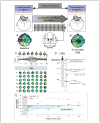Assessment and modulation of neural plasticity in rehabilitation with transcranial magnetic stimulation
- PMID: 21172687
- PMCID: PMC3951769
- DOI: 10.1016/j.pmrj.2010.10.015
Assessment and modulation of neural plasticity in rehabilitation with transcranial magnetic stimulation
Abstract
Despite intensive efforts to improve outcomes after acquired brain injury, functional recovery is often limited. One reason for this limitation is the challenge in assessing and guiding plasticity after brain injury. In this context, transcranial magnetic stimulation (TMS), a noninvasive tool of brain stimulation, could play a major role. TMS has been shown to be a reliable tool for measuring plastic changes in the motor cortex associated with interventions in the motor system, such as motor training and motor cortex stimulation. In addition, as illustrated by the experience in promoting recovery from stroke, TMS is a promising therapeutic tool to minimize motor, speech, cognitive, and mood deficits. In this review, we will focus on stroke to discuss how TMS can provide insights into the mechanisms of neurologic recovery and how it can be used for measurement and modulation of plasticity after an acquired brain insult.
Copyright © 2010 American Academy of Physical Medicine and Rehabilitation. Published by Elsevier Inc. All rights reserved.
Figures


References
-
- Andlin-Sobocki P, Jonsson B, Wittchen HU, Olesen J. Cost of disorders of the brain in Europe. Eur J Neurol. 2005 Jun;12( Suppl 1):1–27. - PubMed
-
- Rossini PM, Calautti C, Pauri F, Baron JC. Post-stroke plastic reorganisation in the adult brain. Lancet Neurol. 2003 Aug;2(8):493–502. - PubMed
-
- Seitz RJ, Azari NP, Knorr U, Binkofski F, Herzog H, Freund HJ. The role of diaschisis in stroke recovery. Stroke. 1999 Sep;30(9):1844–1850. - PubMed
-
- Pascual-Leone A, Amedi A, Fregni F, Merabet LB. The plastic human brain cortex. Annu Rev Neurosci. 2005;28:377–401. - PubMed
-
- Dijkhuizen RM, Asahi M, Wu O, Rosen BR, Lo EH. Delayed rt-PA treatment in a rat embolic stroke model: diagnosis and prognosis of ischemic injury and hemorrhagic transformation with magnetic resonance imaging. J Cereb Blood Flow Metab. 2001 Aug;21(8):964–971. - PubMed
Publication types
MeSH terms
Grants and funding
LinkOut - more resources
Full Text Sources
Medical

